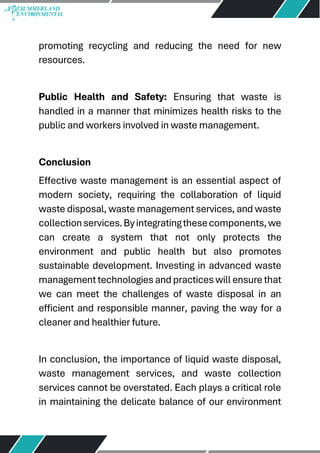The 9-Minute Rule for Reclaim Waste
The 9-Minute Rule for Reclaim Waste
Blog Article
Our Reclaim Waste Statements
Table of ContentsThe Buzz on Reclaim WasteGetting My Reclaim Waste To Work9 Simple Techniques For Reclaim WasteReclaim Waste Things To Know Before You Get ThisThe Definitive Guide for Reclaim Waste
Check out the types, events, and types of liquid waste. Residential sewage waste describes the waste and items from a property septic storage tank. This kind of waste is developed by human beings in residences, schools, and various other buildings. This only consists of septic systems that have a drainpipe field. The correct monitoring and disposal of domestic sewer waste require fluid waste to be moved to a sewer therapy plant where the correct techniques and equipment are put on detoxify and throw away waste.
Business waste often consists of potential hazards, such as flammable materials or a mixture of liquid and solid waste products, and needs a more sophisticated and thorough disposal procedure. The disposal of commercial waste usually includes the filtration of waste before transportation to make sure risk-free and correct disposal. Industrial waste is developed from by-products and overflow of industrial processes and manufacturing.
This kind of waste can not use the very same sewage monitoring transport or procedures as septic or industrial fluids. The hazardous waste administration process requires the inspection and testing of liquid waste prior to it goes through the disposal process (liquid waste removal). Drainage waste is the liquid waste that comes from drainage and excess stormwater in very booming locations or cities
Overflow waste can create contamination and flooding if not taken care of effectively. Making certain correct waste monitoring can avoid catastrophes and decrease environmental injury.
Getting The Reclaim Waste To Work
Contact PROS Services today to discover our waste monitoring and disposal services and the correct means to care for the fluid waste you create.
(https://share.evernote.com/note/7e2c20e2-4e08-1523-1aa2-d06cf7e27761)Do you know what occurs to your water when you end, flush the bathroom or drain pipes the washing equipment? No? Well, it deserves understanding. This supposed 'wastewater' is not just an essential source but, after therapy, will certainly be released to our land, waterways or the sea. Made use of water from commodes, showers, bathrooms, cooking area sinks, washings and commercial processes is recognized as wastewater.

water utilized to cool machinery or clean plant and equipment). Stormwater, a type of wastewater, is runoff that moves from farming and metropolitan areas such as roofing systems, parks, yards, roadways, paths and gutters right into stormwater drains pipes, after rainfall. Stormwater moves neglected directly to local creeks or rivers, at some point reaching the ocean.
Some Known Details About Reclaim Waste
In Queensland, most wastewater is treated at sewer treatment plants. Wastewater is transported from domestic or commercial sites through a system of sewers and pump stations, referred to as sewage reticulation, to a sewage treatment plant. Regional federal governments construct, maintain and operate most sewer treatment plants. Operators are accredited under the Environmental Protection Act 1994 to release cured wastewater at an appropriate ecological requirement into rivers.
The Department of Natural Resources encourages regional federal governments concerning handling, operating and keeping sewerage systems and therapy plants. In unsewered areas, neighborhood federal governments may require householders to mount specific or family sewage therapy systems to treat domestic wastewater from bathrooms, kitchen areas, restrooms and laundries. go to the website The Department of Natural Resources authorizes using family systems when they are shown to be effective.
A lot of stormwater gets no treatment. In some new subdivisions, treatment of some stormwater to eliminate litter, sand and gravel has actually started utilizing gross contaminant catches. Wastewater treatment occurs in four phases: Eliminates strong matter. Bigger solids, such as plastics and various other objects wrongly released to drains, are gotten rid of when wastewater is passed with displays.
Makes use of tiny living microorganisms recognizes as micro-organisms to break down and remove continuing to be dissolved wastes and great bits. Micro-organisms and wastes are included in the sludge.
Some Known Incorrect Statements About Reclaim Waste
Nutrient removal is not available at all sewage therapy plants because it needs expensive specialised equipment. Clear liquid effluent produced after treatment might still consist of disease-causing micro-organisms - liquid waste removal melbourne.

The majority of wastewater flows right into the sewerage system. Under the Act, neighborhood federal governments carry out authorizations and licences for eco appropriate activities (Ages) including wastewater releases that may have a neighborhood influence.
Facts About Reclaim Waste Uncovered
Otherwise, examples are considered research laboratory analysis. Often many examinations are needed to establish the degrees of each of the various toxins such as oils, heavy metals and chemicals in water. Monitoring provides accurate information about water quality and can confirm that permit conditions are being met. The information acquired with monitoring gives the basis for making water top quality choices.
Report this page